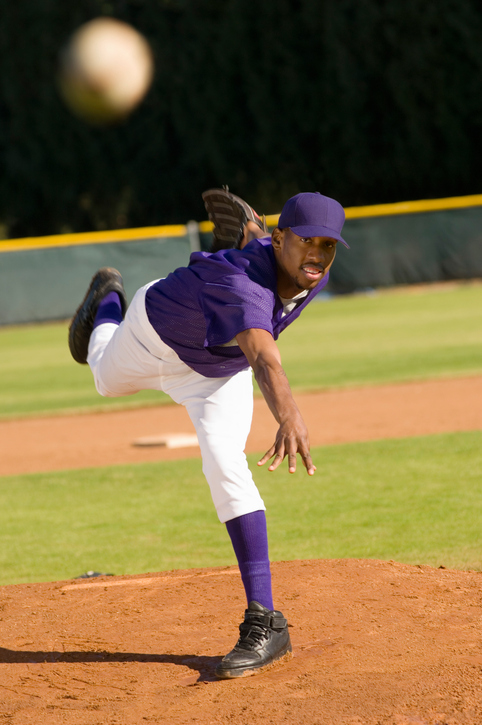
The pitcher stands in the center of the diamond and throws the ball for the batters to try to hit. The pitcher is the key person on the team, and can pitch from a windup or a set. To do a windup, stand on or directly in front of and touching the rubber with your toes pointing toward home plate. Then, take one step toward the plate and throw the ball toward the catcher. In a set position, stand on or directly in front of and touching the rubber, with your toes pointing toward the side and your arms apart at your sides. This is called the stretch, and here you may make any natural preliminary motion you wish. Then, you must bring your arms together in front of your body, with a slight stop. After such a pause, you may then step toward home and pitch. In the set position, the time of pitch is that instant when you makes a move toward home plate. Anytime before this instant, you may step toward and throw or fake a throw to a base. If you are pitching well, your team will likely win.
Pitchers usually require at least two or three days of rest between each full game pitched. Relief pitchers, who are normally brought in for only an inning or two, are able to pitch more often. The measure of success for a relief pitcher is the save, which is awarded for preserving a lead.
A pitcher must have one foot on the rubber when pitching. Failure to do this is called a balk, and all base runners are allowed to advance to the next base. A pitcher may also commit a balk by not completing a delivery he or she has started, or by not throwing to either the batter or a base that has a base runner.
If no runners are on base to distract the pitcher with base stealing attempts, the pitcher must pitch the ball within 20 seconds of receiving it. The penalty for delaying the game will be a “ball” for the batter.
A pitcher may not intentionally pitch at the batter. A ball that is thrown at the batter is known as a bean ball. Umpires may either warn pitchers that they could be ejected from the game, or simply eject the pitcher on the spot for throwing a bean ball.
A pitcher can throw a variety of pitches. The most common pitches thrown are the curve ball, fast ball, and the slider. Some other pitches used include the screwball, the sinker, and the knuckle ball. Professional pitchers can throw a ball up to 100 miles per hour.
| Fast Ball | The fast ball is the most common pitch. It is also known as heater, smoke, and big dog. Use this effective pitch to get the batter out most of the time. Grip the ball with your index finger and middle finger across the widest part of the baseball. Hold the ball in your finger tips and release it with your thumb down and two fingers pointed toward the batter. The ball should roll off your two fingers with a backspin, causing it to move upward as it flies toward the batter. |
| Curve Ball | Good curve balls often seem to drop sharply with a sharp rotation as they reach the plate, making the batter swing above them. Hold the ball deeper in your hand. Release it with your palm up, and a twist of your wrist, with your thumb toward the batter. This creates a sidespin, which causes the ball to break away from the batter. |
| Change-Up | The change-up is an off-speed pitch, usually thrown to look like a fastball, but arriving much slower to the plate. It is meant to confuse the batter’s timing. |
| Slider | This ball is a cross between the curve and the fast ball. Deliver it from your fingertips with your hand in a handshake position. A good slider breaks faster and later than a curve does. |
| Knuckle Ball | This is a very difficult pitch to deliver. Press the ball against knuckles of two or three of your fingers with your thumb, and deliver it with the motion of a fast ball. The ball should have no spin in flight, making it able to and can break suddenly in any direction. |
| Screwball | A screwball breaks in the opposite direction of a curveball. Deliver it with a twist of your wrist and thumb, which should be turned sharply down and outward. The side spin causes the ball to break toward the batter. This pitch is hard on the pitcher’s arm. |
